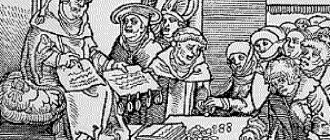The standard list of deadly sins presented in this article: lust, gluttony, greed, sloth, anger, envy and pride, as opposed to the seven virtues (chastity, moderation, mercy, industry, patience, kindness and humility).
This list is clearly familiar to you, even if you are not a religious person at all. The concept of sinfulness, or the difference between right and wrong, goes back a long way, even before Christianity established itself as one of the world's major religions.
Before Christianity
Even before we talked about original sin, where Adam and Eve shamefully devoured the fruit that was forbidden to them, ancient civilizations were already thinking about this topic. This is evidenced by various correlative inscriptions on cuneiform tablets left by ancient Mesopotamian civilizations.
From the fourth to the first millennium BC, in the Tigris-Euphrates river system, peoples wanted answers to persistent questions, such as: why is there suffering in the world or why will some people experience more hardship than others? Great suffering was associated with the punishments inflicted by the gods in heaven.
Questions such as “did he become intimate with his neighbor’s wife?” were found on cuneiform tablets. or “Did he break into his neighbor’s house?” and “Did he commit a sin against a god or a goddess?”
A beautiful wicker basket made from old bags: it looks great in the interior
How did Konchalovsky's daughter manage to lose 30 kg? Maria's power system
Why do most Russians prefer apartments to hotels when traveling?
It is believed that the Sumerians and Akkadians, who dominated Mesopotamia, knew the principles of good and bad behavior centuries before the completion of the Bible.
Angel of the Throne
Humanity has long been looking for answers to the question of what is the cause of social upheavals, epidemics, economic crises, environmental and industrial disasters, natural disasters and brutal terrorist attacks that increasingly befall us every year.
Meanwhile, the reason is simple - and it was mentioned two thousand years ago. These are our sins, the main ones of which are pride, greed, envy, anger, gluttony, despondency, fornication. There is a certain critical mass of sin, when the atrocities of people overwhelm the earth and it ceases to fulfill its functions, that is, it dies. And man disappears from this earth. This has happened more than once throughout human history. Premonitions of the approaching end of the world do not deceive humanity. But today the seven deadly sins are so familiar and widespread that they have long been no longer considered something reprehensible. However, all spiritual teachings assert that, following the lead of these passions, a person commits much more serious acts: he deceives, betrays, slander, steals, rapes, kills others or himself, that is, he commits crimes that are punishable both on earth and in the sky. But why should we, civilized people and free from all church dogmas, be guided by some lists of sins? And the name “mortals” was clearly invented to intimidate gullible parishioners!
However, everything is not so simple. Our world is designed in such a way that we constantly have to choose between darkness and light, good and evil, God and the devil. Someone wise said: “The victory of the devil is that he convinced people that he does not exist.” And therefore we choose darkness, not light, the devil, not God. The discoveries of modern physics and biology suggest that these are not metaphors at all. Each of us is guilty of one, several or even all mortal sins at once, without even knowing it. And those who know wave their hands in despair: anyway, you’ve already sinned so much that you can’t help! But it depends only on us whether this terrible funnel will spin us around or whether we will be able to climb out of it and save ourselves. The film tells in detail how the list of the seven deadly sins appeared and why they are considered the main among human vices. Theologians, teachers, priests of various faiths, scientists, as well as ordinary people who have experienced the destructive power of these sins will talk about their impact on people, the consequences they lead to. There are seven deadly sins in total (the Latin names are given in brackets): Anger (Ira) Lust (Luxuria) Gluttony (Gula) Envy (Invidia) Dejection (Acedia) Pride (Superbia) Greed (Avaritia)
Production: TV channel "RUSSIA" Director: Alexander Smirnov
Negative confessions
Likewise, the people of Ancient Egypt had an understanding of good and evil, although the Ancient Egyptians believed that they could prove their innocence before the gods. This was done by correctly stating statements of innocence among scholars, known as "negative confessions."
Examples of “negative confessions” can be found in the papyrus “Book of the Dead,” which describes the journey of the deceased to the underworld. “I committed no sin,” “I did not work with a sorcerer against the king,” or “I did not steal grain” are some of the forty-two such statements that the soul must affirm while awaiting the Day of Judgment.
Tips for Sketching
“The 7 Deadly Sins” is a tattoo that every artist sees differently. In addition to the classic sketches that are available in any specialized salon, you can develop an individual copy. To do this, you need to decide what should be in the picture, its size and color, and consult with a specialist.
The artist will draw every detail of the blank on paper and it can be tried on the selected area of the body. You can also develop a sketch on a computer using drawing programs. In this case, the finished picture is printed on special paper and also tried on the body.
When developing or selecting sketches, we focus on the client’s individual wishes and characteristics. In addition, you need to take into account the shape of his body and choose a pattern that will look organic on the skin.
In the case when a person wants to inflict 1 of the deadly sins on the body, then you need to correctly choose which one is suitable in a particular case. To do this, it is recommended to try on and feel all 7.
You should not fill in a picture that causes even the slightest negative feeling in your soul, because then the picture will irritate and cause negative emotions, which is not desirable. Sometimes such mistakes end with the old design being completely covered by a new one or the tattoo being erased.
The sketch is also selected in accordance with the location of the tattoo. Large pictures with many details and elements look good on the shoulder or back. Moreover, they can be either color or black and white.
It is better to apply small, light designs on the wrist or inner part of the hand. Massive canvases here look heavy and inappropriate.
The “7 Deadly Sins” tattoo is a picture that carries a great moral and semantic load, both to its owner and to those around him. Before choosing such an image, you need to carefully weigh all the pros and cons, because the drawing is not made for a year or 2, but for life. At the same time, it will be difficult to get rid of the picture, and the procedure itself is very painful.
Seven deadly sins
The Seven Deadly Sins were more or less outlined by Pope Gregory the First. He refined the list sometime in the late sixth century AD to teach people to do the right thing. Such a list cannot be found in the scriptures, but the concept is essentially biblical. A few more names are worthy of mention, as these men attempted to organize lists of sins or virtues before Pope Gregory the First.
Russians were warned about weather anomalies in the next five days
In the program “The Stars Aligned,” Skulkina told how she behaves outside the cameras
KAMAZ and alternative energy sources: development of hydrogen vehicles is underway
Color and location
“7 Deadly Sins” tattoos are usually placed on large areas of the body, such as the arms, chest or back. Less common, but found, are small pictures with classical church symbols on the wrist or foot.
When choosing a place, esotericists recommend finding out what this or that part of the body is responsible for. For example, the back symbolizes the past and endurance, and the neck is responsible for intuition. The hands are responsible for creation and protection, and the chest is responsible for feelings and emotions.
Psychologists have found that color has its own influence on a person. In the right amount it heals, but in excess it can cause uncontrolled reactions and destructive processes.
Most often, when applying a tattoo, the color black is used, which symbolizes absolute, harmony and inner strength. An excess of this color can lead to depression, and the right amount will increase self-confidence and restore pragmatism and determination.
Red, which is also found in tattoos with the 7 deadly sins, can stimulate a person to be active and fill him with energy. An excess of this color can cause apathy in the tattoo wearer and aggression in others.
Most people associate orange shades with summer and warmth. At the same time, excess color leads to insomnia and decreased appetite.
A well-chosen color scheme will help to correctly recreate the desired plot and convey the intention of the master and the customer.
Evagrius of Pontus
In the fourth century AD, a Christian theologian, Byzantine philosopher, and a famous monk of that time tried to give a clearer list of mortal sins. His name was Evagrius Pontius and he was a Christian mystic and writer whose development of a theology of contemplative prayer and asceticism laid the foundation for a tradition of spiritual life in both the Eastern and Western churches. Moreover, his philosophy is sometimes seen as the Christian equivalent of Zen Buddhism.
Ponticus saw sinfulness as eight thoughts of evil. He listed them in Greek, and they included: gastrimargia, denoting gluttony, porneia, fornication or prostitution, hyperephania, or pride, acedia, or acedia (understood as the effect of spiritual alienation), philargyria, or greed, kenodoxia, or boasting, org , or anger, and lipe, which meant sadness over someone else's condition and well-being.
No fast food and sugar! The Japanese diet will help you lose weight
Plants can’t do that! The predatory flycatcher is capable of creating a magnetic field
An Italian social worker portrays society truthfully in her illustrations
From the Greek, this concept was eventually translated into Latin by St. John Cassian (John of Massalia), who was a student of Ponticus. He is a monk and theologian, a prominent theorist of monastic life and one of the founders of monasticism in Gaul. Cassian's translation is the source from which the West was introduced to the concept of mortal sins.
In Latin, the above list is as follows: gula as gluttony, luxura or fornicatio as lust and fornication, superbia as pride and arrogance, acedia as sloth, avaricia as greed, vanagloria as pride or vanity, ira as anger and tristitia as sadness and despair .
Moreover, these eight sins were clearly separated. One group included sins associated with lust, such as gluttony and greed. The other involved angry atrocities (caused by anger). The third are sins that affect the mind and corrupt the mind, such as excessive pride or sadness.
Style and size
“The 7 Deadly Sins” is a tattoo that artists perform in different styles and colors. Some people like classic monochromatic pictures, while others want to make permanent “flaws” in color. At the same time, the size of the image can also change: from small on the wrist to large, on the entire shoulder or back.
Most often, 6 techniques are used to apply pictures of sins to the skin:
| Name | Distinctive features |
| Classical | The tattoo is applied with black ink, and there are no sharp lines. |
| Geometry | A black and white picture smoothly transitions from an image into a geometric figure and vice versa. |
| Minimalism | A small drawing in dark ink using a minimum of detail. |
| old school | A colorful tattoo, the contours of which are drawn with thick black lines, and the picture itself is carefully filled with bright shades of paint. |
| Neo-traditional | Most of the elements of the tattoo are drawn in dark shades of ink, and the necessary details are shaded with the chosen bright color. |
| Trash polka | The pictures occupy a large area, and when applying them, black, red and orange or green paint are used. |
The artist will offer everyone in the tattoo parlor several sketches of a thematic design. At the same time, they recommend trying on all the ones you like and trying to feel them on a subconscious level. In the case where the picture causes at least minimal discomfort and internal tension, it should be abandoned, since further wearing it will only aggravate the situation.
Circles of Hell
The concept of hell first appeared in the biblical New Testament. Christians were convinced that after death sinners go to the afterlife, where they are subjected to suffering and torment. After going through 7 circles of hell, they are cleansed of filth and can be accepted into heaven. A specific sin is clearly attached to each section, the punishment for it is determined in advance. No one says exactly how many circles of hell the offender must cross, but the hierarchy of the underworld changes in Catholicism. Aristotle increased the number of circles to nine, and then his idea was picked up by the Italian thinker Dante Alighieri.











